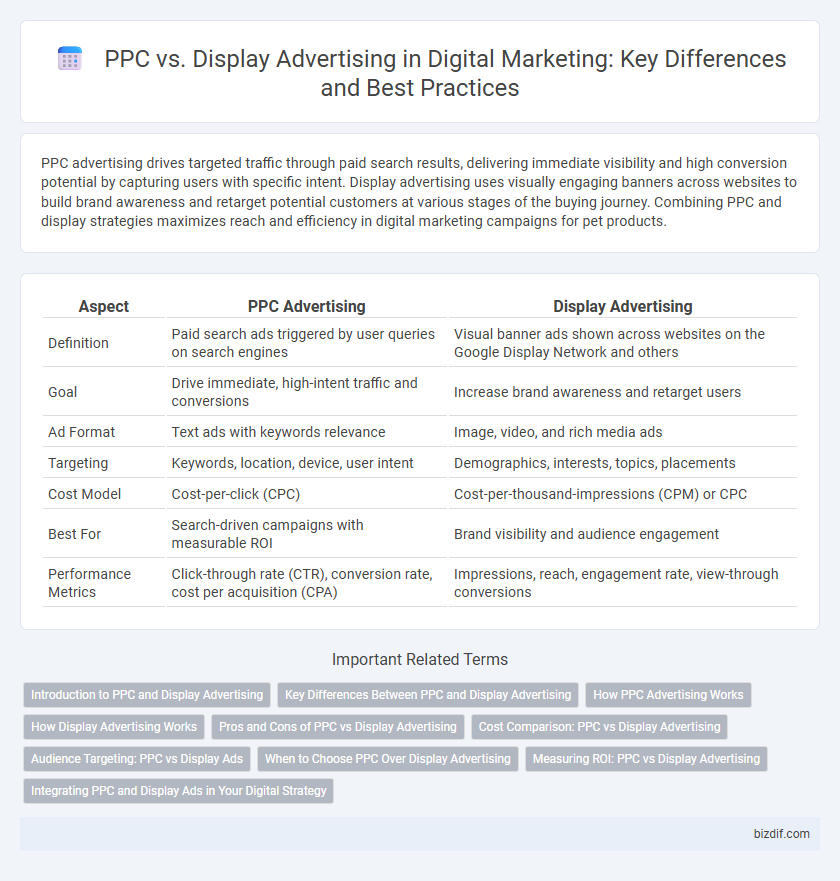PPC advertising drives targeted traffic through paid search results, delivering immediate visibility and high conversion potential by capturing users with specific intent. Display advertising uses visually engaging banners across websites to build brand awareness and retarget potential customers at various stages of the buying journey. Combining PPC and display strategies maximizes reach and efficiency in digital marketing campaigns for pet products.
Table of Comparison
| Aspect | PPC Advertising | Display Advertising |
|---|---|---|
| Definition | Paid search ads triggered by user queries on search engines | Visual banner ads shown across websites on the Google Display Network and others |
| Goal | Drive immediate, high-intent traffic and conversions | Increase brand awareness and retarget users |
| Ad Format | Text ads with keywords relevance | Image, video, and rich media ads |
| Targeting | Keywords, location, device, user intent | Demographics, interests, topics, placements |
| Cost Model | Cost-per-click (CPC) | Cost-per-thousand-impressions (CPM) or CPC |
| Best For | Search-driven campaigns with measurable ROI | Brand visibility and audience engagement |
| Performance Metrics | Click-through rate (CTR), conversion rate, cost per acquisition (CPA) | Impressions, reach, engagement rate, view-through conversions |
Introduction to PPC and Display Advertising
Pay-per-click (PPC) advertising involves advertisers paying each time a user clicks on their ad, typically appearing on search engine results pages to target intent-driven queries. Display advertising uses visually engaging banners or video ads placed on websites within an ad network to build brand awareness and retarget potential customers. Both strategies leverage data-driven targeting options but serve different goals: PPC focuses on direct response and conversions, while display advertising enhances visibility and audience engagement.
Key Differences Between PPC and Display Advertising
PPC (Pay-Per-Click) advertising targets users actively searching for specific keywords, generating highly intent-driven traffic and measurable ROI through platforms like Google Ads. Display advertising, relying on banner ads across websites, emphasizes brand awareness and visual engagement rather than immediate conversions. Key differences include targeting methods, with PPC focusing on search intent and display ads leveraging audience demographics, and cost models, where PPC charges per click and display often uses CPM (cost per thousand impressions).
How PPC Advertising Works
PPC advertising operates on a pay-per-click model where advertisers bid on keywords relevant to their target audience, ensuring ads appear in search engine results or partner sites only when users search for specific terms. Each click drives potential traffic to the advertiser's website, allowing precise budget control and performance tracking through metrics like click-through rates (CTR) and cost per acquisition (CPA). This model delivers highly targeted exposure and measurable ROI, making it a preferred digital marketing strategy for lead generation and sales conversion.
How Display Advertising Works
Display advertising works by using visually engaging banner ads placed on websites, targeting specific audiences through data such as interests, demographics, and browsing behavior. These ads leverage programmatic buying and real-time bidding to maximize reach and relevance while driving brand awareness and remarketing opportunities. Unlike PPC, which focuses on direct response through paid search, display advertising aims to capture attention and build brand recognition across a broad network of sites.
Pros and Cons of PPC vs Display Advertising
PPC advertising offers precise targeting and higher conversion rates due to intent-driven clicks but often incurs higher costs per acquisition, making it ideal for direct response campaigns. Display advertising excels in brand awareness and retargeting with visually engaging creatives across a broad audience, yet it typically shows lower click-through rates and can suffer from ad blindness. Balancing PPC's measurable ROI with display's expansive reach allows marketers to optimize digital strategies based on campaign goals and budget constraints.
Cost Comparison: PPC vs Display Advertising
PPC (Pay-Per-Click) advertising typically involves higher costs per click due to targeted keyword bidding, making it more expensive but potentially more effective for direct conversions. Display advertising usually has lower costs per thousand impressions (CPM), offering broader brand visibility at a reduced expense but often with lower click-through rates. Businesses must weigh PPC's higher cost and conversion efficiency against Display's cost-effective exposure when planning digital marketing budgets.
Audience Targeting: PPC vs Display Ads
PPC (Pay-Per-Click) advertising allows precise audience targeting through keywords, search intent, and location, capturing users actively searching for specific products or services. Display advertising leverages demographic, behavioral, and interest-based targeting to reach broader audiences across websites, enhancing brand visibility and awareness. Combining PPC's intent-driven approach with display ads' expansive reach optimizes digital marketing campaigns for maximum audience engagement and conversion potential.
When to Choose PPC Over Display Advertising
Choose PPC advertising over display advertising when your primary goal is to drive immediate, high-intent traffic and achieve measurable conversions through targeted keyword bidding. PPC campaigns excel in capturing users actively searching for specific products or services, making them ideal for lead generation and direct sales efforts. Display advertising suits brands aiming to increase awareness and retarget users but lacks the immediate conversion focus that PPC provides.
Measuring ROI: PPC vs Display Advertising
PPC campaigns provide precise ROI measurement through direct attribution of conversions to specific clicks, enabling marketers to track cost-per-acquisition and conversion rates effectively. Display advertising often drives brand awareness and engages users indirectly, making ROI measurement reliant on broader metrics like view-through conversions and impression-based attribution models. Leveraging advanced analytics platforms and conversion tracking tools is essential for comparing the ROI impact of PPC and display advertising within digital marketing strategies.
Integrating PPC and Display Ads in Your Digital Strategy
Integrating PPC and display ads in your digital marketing strategy amplifies reach and conversion by leveraging PPC's intent-driven search traffic alongside display's expansive visual brand awareness. Combining Google Ads PPC campaigns with targeted display placements enhances retargeting effectiveness, ensuring potential customers are engaged across multiple touchpoints. Utilizing advanced audience segmentation and data analytics maximizes ROI, allowing marketers to optimize ad spend by aligning high-intent keywords with visually compelling display creatives.
PPC vs Display advertising Infographic

 bizdif.com
bizdif.com